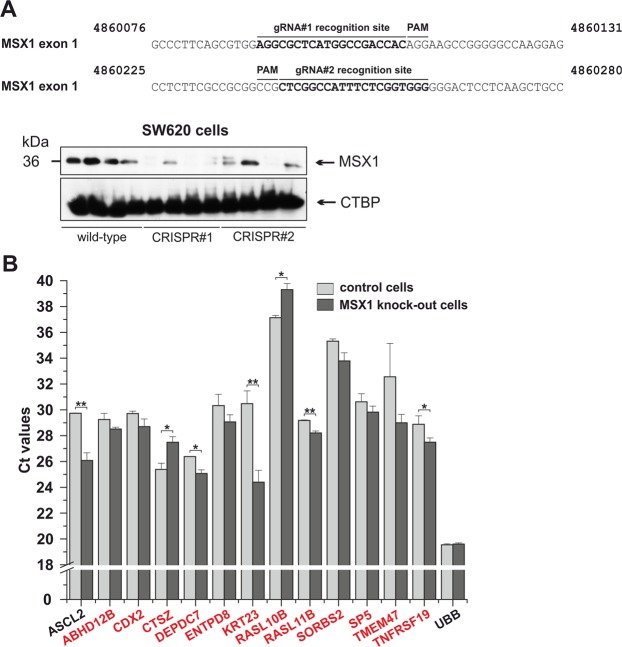Figure 7.
Generation and analysis of human CRC SW620 cells harboring truncations in the MSX1 gene. (A) Top, DNA sequences showing guide RNA (gRNA) recognition sites (in bold) of CRISPR/Cas9-targeted regions in the first MSX1 exon. The numbers above the sequence indicate nucleotide positions in the human genome assembly GRCh38:CM000666.2. Bottom, Western blotting of SW620 cell lysates confirmed reduction of MSX1 protein in cells harboring the modified MSX1 alleles; four different cell clones are shown for both MSX1-specific gRNAs (indicated CRISPR#1 and CRISPR#2). Wild-type refers to control cells transduced with the lentiCRISPR vector encoding no gRNA. (B) Quantitative RT-PCR analysis of expression levels of the indicated genes in MSX1 knock-out and MSX1 wt SW620 cells. Genes identified in ref.24 are in red. RNA samples isolated from four MSX1-deficient and four MSX1-proficient cells clones was analyzed (each in technical triplicate). The diagram shows Ct values normalized to β-actin gene expression (Ct value arbitrary set to 17). Error bars indicate standard error of mean (SEM); *p < 0.05; **p < 0.01. ABHD12B, Abhydrolase Domain Containing 12B; CDX2, Caudal Type Homeobox 2; CTSZ, Cathepsin Z; DEPDC7, DEP Domain Containing 7; ENTPD8, Ectonucleoside Triphosphate Diphosphohydrolase 8; KRT23, Keratin 23; RASL10B, RAS Like Family 10 Member B; RASL11B, RAS Like Family 11 Member B; SORBS2, Sorbin And SH3 Domain Containing 2; SP5, Sp5 Transcription Factor; TMEM47, Transmembrane Protein 47.

